Japan
Wood Products Prices
Dollar Exchange Rates of 10th
June
2019
Japan Yen 108.39
Reports From Japan
Trade war impacting markets in the
Asia-Pacific
A key index reflecting the state of the Japanese economy
rose in April but the improvement was not enough to
change the government’s assessment that the economic
outlook is “worsening,”
The Cabinet Office data on manufacturing is positive but
not strong enough to upgrade the economic assessment.
The biggest issue is that companies in Japan continue to
see looming risks from the US-China trade war and the
impact this is having on their markets in the Asia-Pacific
region.
https://asia.nikkei.com/Economy/Japanese-business-sentimentfalls-
to-lowest-point-in-two-years
In related news, Bank of Japan Governor, Haruhiko
Kuroda, has maintained his view the global economy will
recover in the latter half of this year saying he sees the
global economy stabilising from its recent weakness.
The biggest problem for the government in its efforts to
beat deflation is the weakness in household spending. In
April household spending rose less than expected and real
wages declined. Spending grew 1.3% from a year earlier
in April, up for a fifth straight month, but well below
forecasts.
On a month-on-month basis, household spending fell 1.4%
in April after the slight rise in March. To achieve its 2%
inflation target the BoJ needs an improvement in domestic
consumption which accounts for over half of Japan’s
economic growth.
Government optimistic on April to June machinery
orders
Private-sector machinery orders, an indicator of business
sentiment, increased a seasonally adjusted by 3.8% in
March but overall was down by 3.2% in January-March
2019 compared to a year earlier.
Analysts in Japan’s Cabinet Office have forecast an 11%
rise in orders in the April to June period but the data is not
yet available to check the accuracy of this projection.
For details see:
https://www.esri.cao.go.jp/en/stat/juchu/1903juchu-e.html
Consumer confidence - consumers reluctant to spend
The May Consumer Confidence Survey conducted by the
Cabinet Office shows consumer confidence declined
further. The overall index fell to 39.5 in May a new low
point.
Among the various indices, the index for households’
inclination to buy durable consumer goods declined in
May along with those measuring expectations on
employment, livelihood and income growth.
Japan’s economy has hit a wall as the U.S.-China trade
war intensifies and global demand continues to weaken.
On the domestic front consumers are reluctant to spend.
Retail sales mirror the continued decline in consumer
confidence as evidenced by the consumer confidence
indices which show weakness.
Consumer spending remains weak as wages have not risen
and if exports falter this could drive both corporate and
consumer sentiment lower.
See: https://www.esri.cao.go.jp/en/stat/shouhi/shouhi-e.html
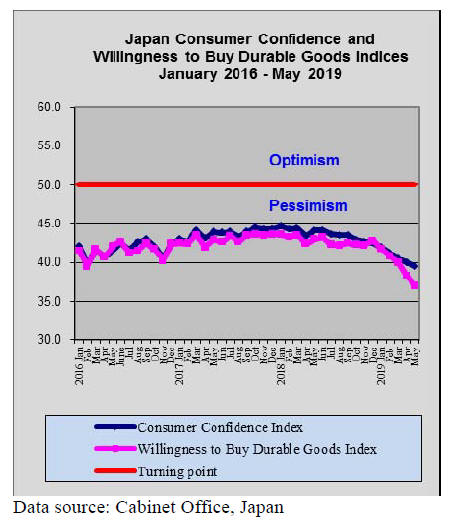
US$/Yen exchange rate more volatile
The US dollar has been weakening over the past week
against many major currencies, due to fresh signs of
weakness in the US economy, as well as more
protectionist rhetoric from the government.
While the US dollar is the traditional safe currency
concerns that the US economy could slowdown has caused
a rush to yen. In recent weeks the US$/Yen exchange rate
has become more volatile and the yen has surged against
the US dollar. In the second week of June the yen had
strengthened to around 108 to the US dollar.
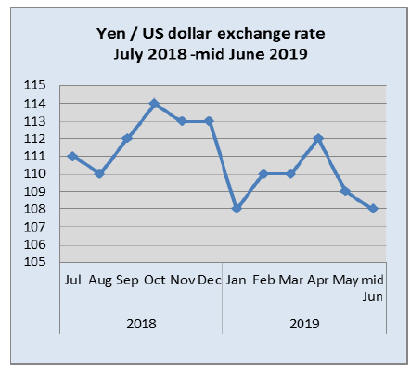
Renewed interest in China for Japanese
property
The Japanese media have recently reported on the renewed
interest in Japanese property by Chinese buyers saying
there has been a surge in interest since the beginning of the
year roughly around the time that trade tensions between
Beijing and Washington intensified.
One of the largest international real estate companies
helping Chinese invest in overseas property has seen
interest in US properties drop and a surge in interest in Japan.
Japanese properties in demand include those in residential
areas in Tokyo and Osaka where Chinese buyers look for a
buy-to-let property or a home for children studying in
Japan.
This is not the first time Japan has seen a surge in Chinese
demand. In 2017 Japan experienced a boom in speculative
property buying by Chinese investors. The current
investors are especially interested in Osaka which will
host the 2025 World Expo and will be home to Japan’s
first casino.
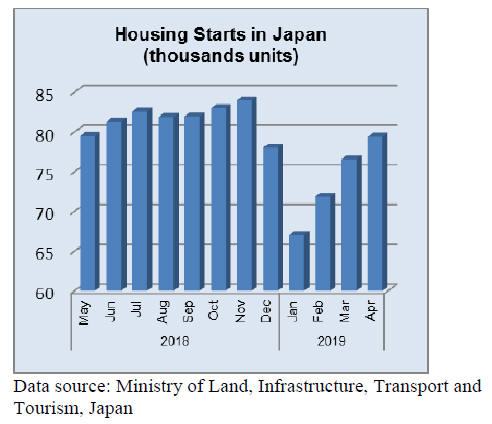
Import update
Wooden door imports
Year on year, the value of Japan’s April wooden door
imports rose14% but compared to the value of imports in
March there was a 10% decline in April.
In April the top shippers of wooden doors to Japan were
China and the Philippines. Shippers in China accounted
for 60% of April imports of wooden doors followed by the
Philippines (24%).
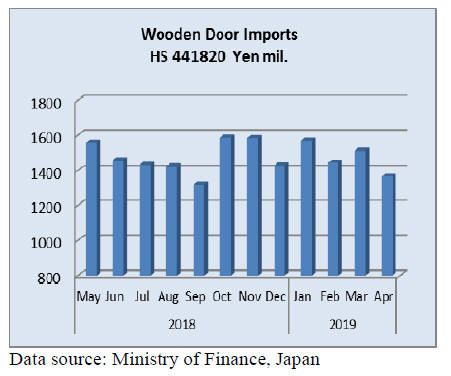
Wooden window imports
Japan’s April 2019 wooden window imports were little
changed from the values imported in April 2018.
Similarly, month on month April imports were unchanged
Just three sources accounted for over 80% of April
imports. China and the US were the main suppliers with
around 33% each of total April window imports. The third
ranked supplier was the Philippines which accounted for a
further 22% of April arrivals.
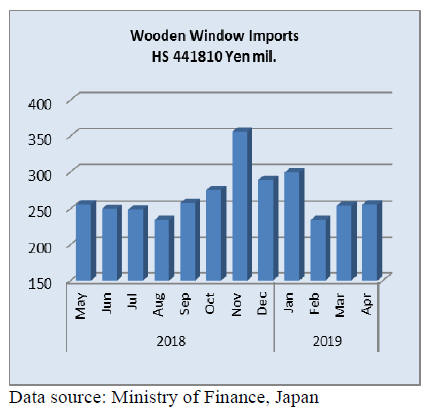
Assembled wooden flooring imports
The value of April assembled flooring imports made a
dramatic recover after dropping sharply in March.
Month on month the value of assembled flooring imports
rose over 70% in April and were up 21% compared to
April 2018.
Japan’s imports of wooden flooring are mainly HS441875
and April imports were dominated by shippers in two
countries, Indonesia and China.
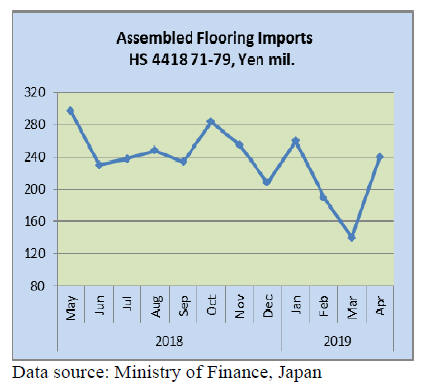
Plywood imports
Japan’s April 2019 plywood imports picked up
significantly rising to 183,000 cubic metres. Plywood
demand remains firm and much of the demand is being
met from domestic raw materials as well as imported
veneer.
The top three plywood suppliers Malaysia, Indonesia and
China continued to dominate Japan’s sources of plywood
imports. April shipments from Malaysia were at the same
level as a year earlier but were up 34% from March.
Shipments from Indonesia were down 22% in April 2019
compared to 2018 and were slightly up from levels in
March.
April shipments from China were around three times the
level in March but were down over 320% year on year.
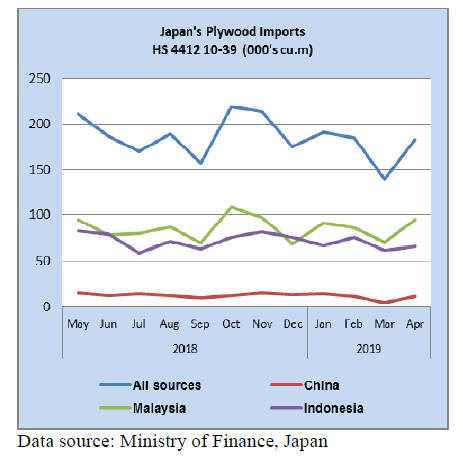
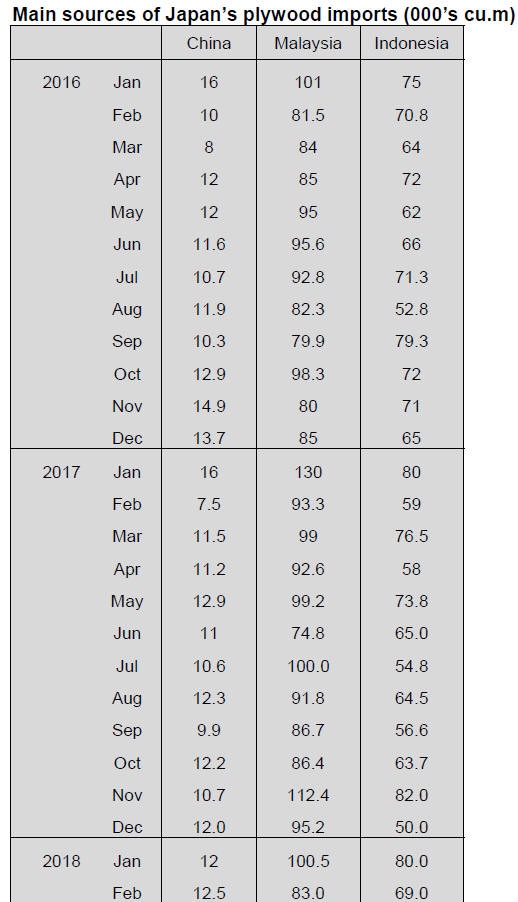 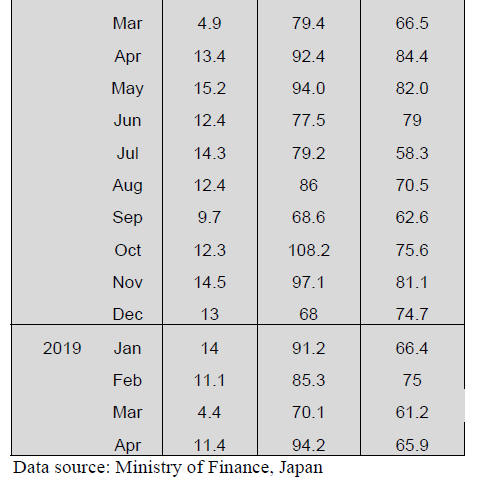
Trade news from the Japan Lumber Reports
(JLR)
The Japan Lumber Reports (JLR), a subscription trade
journal published every two weeks in English, is
generously allowing the ITTO Tropical Timber Market
Report to reproduce news on the Japanese market
precisely as it appears in the JLR.
For the JLR report please see:
http://www.nmokuzai.
com/modules/general/index.php?id=7
National forest business plan for 2019
For the fiscal year 2019 (April 2019 through March 2020),
sales plan is 2,703,000 cbms of logs, 4.1% more than 2018
and 3,310,000 cbms of standing timber.
Harvest plan is 5.4% more of clear cutting and 3.8% less
of thinning so shift to clear cutting is apparent. With
increase of clear cutting, replantation area will be 6,000
hectares, 35.6% more. Continuous operation from clear
cutting to replantation will increase to reduce total cost.
Initial budget for the national forest is 77.2 billion yen,
11.5 billion yen more than 2018.
Sales of logs and timber will increase in 2019. In log sales,
71% would be system sales (sales to particular large users
like sawmills and plywood mills).
Sales volume of timber will increase but it is not certain if
number of buyers increase. Sales volume of timber
doubled in last ten years but about a half of sales were
unsold.
In 2018, for sales volume of 3,200,000 cbms, sold volume
was only 1,530,000 cbms but since 2019, in examination
of system sales of logs, timber purchase volume is
considered as one of conditions so timber purchase should
increase.
For replantation, to reduce cost, use of nursery trees grown
in pot increased, which is easy to plant and trees are
implanted in higher percentage. Number of potted nursery
trees has kept growing year after year and in 2019, it will
be about eight million from two million in 2016.
As case of large lot and long term sales of timber is
increasing, new law requires replantation is now
compulsory for timber purchasers but replantation is done
by budget of the Forestry Agency. In the past, bidding for
timber purchase and replantation have been done
separately but now the purchaser is responsible for
replantation.
Like timber sale in 2015, standard was total area of about
20 hectares and harvest volume of about 6,000 cbms a
year but now large lot like several hundred hectares with
annual harvest volume of several thousand cbms are
planned in ten locations in Japan.
Trade war between the U.S.A. and China
The U.S. government decided to increase retaliatory
import duty on about 5,700 items from 10% to 25%. These
include plywood, furniture, lumber and logs.
Chinese government announced to take necessary actions
for retaliation. If import duty for imported logs from the
U.S.A. is raised, it would be a big blow to forest products
trade between two countries and it would give impact to
worldwide wood demand and supply.
The U.S.A. exports logs and lumber to China then China
exports processed products like plywood and furniture.
Forest products trade between two countries in 2017
before the conflict started was about 3.2 billion dollars by
the U.S.A. and about 4.0 billion dollars by China so total
amount was 7.2 billion dollars.
Export by China has been unchanged much in recent years
but export by the U.S.A. has been increasing year after
year and it is 25.6% more than 2017 and 54.6% more than
2015. In 2018, in export to China, logs were 6,265,783
cbms, 2.4% more than 2017 but lumber was 2,696,084
cbms, 17.3% less than 2017.
In log export, softwood logs were 5,130,815 cbms, 4.5%
more and hardwood logs were 1,134,968 cbms, 6.2% less.
In lumber, hardwood was 2,017,942 cbms, 16.1% less and
softwood was 678,142 cbms, 20.5% less. Import duty
varies by products and species, which influenced purchase
volume.
It is not certain how much of these are processed
and are exported to the U.S. market but the volume of logs
and lumber from the U.S.A. takes about 10% in total wood
supply so China may need to look for substituting supply
source but China’s export to the U.S.A. would decrease so
how much China would need in balance is not certain.
The U.S. government is preparing to impose import duty
on rest of remaining items and as the conflict gets bogged
down, impact would be serious not only on Chinese
economy but also on rest of the world.
U.S. domestic lumber market has been slow since second
half of last year and if export to China declines, U.S.
depressed market is likely to prolong.
Price hike of softwood plywood
Softwood plywood manufacturers have been suffering
climb of log cost and transportation cost. These increased
about by 10% in last one year.
The manufacturers say that transportation cost has been
the manufacturers’ since delivery term is arrived at
buyers’ desirable place but transportation cost has been
climbing without no end recently.
Trucking companies ask higher cost of drivers and charge
waiting time. The rule requires two drivers for long
distance delivery so bearing such higher transportation
cost is becoming difficult for the plywood manufacturers
so delivery term may change to FOB mill and
transportation cost would be buyer’s account in future.
Also log cost has been increasing by purchase competition
with other users like sawmills and biomass power
generation plants. In Kyushu, log prices climbed by about
20% to 11,000 yen per cbm FOB log yard of auction
markets because of competition with lumber mills and
wood chip plants for biomass power plants.
Shinyei’s new plywood mill will start up shortly at Ohita.
This mill plans to use 30% of cypress logs in total log
consumption and cypress log prices soared to about 17,000
yen, more than 10% increase so neighboring sawmills are
worried about future log procurement.
Some of log market in the Western Japan shows about
25% increase of cedar B class logs at 12,000 yen. In the
North East, larch log prices climbed by about 20% and
cedar log prices are up by about 10%.
The manufacturers have been holding offer price of 1,050
yen per sheet delivered on JAS 12 mm 3x6 plywood for
last one year despite temporary supply shortage by
demand increase to establish stable supply market.
Actually the market prices have been way under 1,050 yen
so at this time, the manufacturers are asking to bring the
actual prices back up to 1,050 yen to cover higher cost.
Majority of plywood is sold direct to precutting plants and
the prices vary by plants while wholesale channels’
volume is much less than precutting business so wholesale
prices do not reflect actual market prices. Since the prices
between precutting plants and plywood mills are not
disclosed, actual prices are not clear but they appear about
5% lower than the proposed prices by plywood mills.
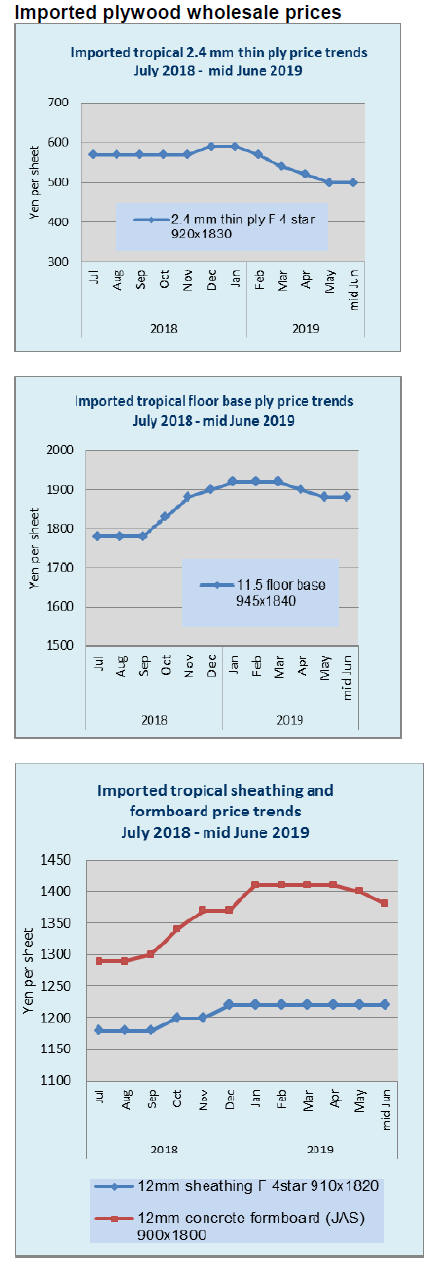
South Sea (tropical) logs and lumber
Import of logs from PNG has been stable and the first
quarter volume from PNG is 40% more than last year.
With stable supply, log market prices in Japan are holding
steady. Logs from Sabah, Malaysia, is zero by export ban
and log supply from Sarawak, Malaysia has no hope to
recover by reduction of export quota and soaring harvest
cost.
As quality logs from South Sea countries to manufacture
face and back are hard to get now, plywood mills in Japan
are developing to make hybrid plywood with domestic
cedar and imported falcate veneer.
Laminated free board had some active trading from early
this year with declining inventories but now the movement
slow down as this is demand slow season. The prices of
Indonesian mercusii pine and Chinese red pine are
unchanged at about 110,000 yen plus.
MDF market
Total supply of MDF in 2018 was 1,007,830 cbms
(395,727 cbms of domestic products and 612,103 cbms of
overseas supply).
Domestic supply dipped below 400,000 cbms after three
years while the imports exceeded 600,000 cbms after five
years. Decrease of domestic supply is production disrupt
by occasional mechanical problems of the manufacturers.
Among imports, Indonesia supply increased by 28.6%
from 2017.
For raw materials supply, softwood materials were steady
for both domestic and imports but South Sea hardwood
chip is becoming hard to procure because of harvest
restrictions in South Sea countries.
Driving demand in Japan is thin MDF for flooring. As
supply of floor base of tropical hardwood is shrinking year
after year, demand of composite floor with combination of
MDF and domestic softwood plywood or tropical
plantation species have been increasing.
Production of composite floor with MDF and softwood
plywood or single use of MDF has been increasing from
about 42,000 M square meter in 2016 to 44,150 M square
meter in 2018.
There was not much change in demand of thick softwood
MDF for building materials. To deal with changing
demand of MDF, acquisition of overseas MDF plant is
progressing to secure the supply for Japan market. This
helps reduce risk of supply disruption by having various
supply sources.
Meantime, demand retreat is feared in Japan after the
consumption tax is raised to 10% in October so if the
supply from overseas plants increase, there would be
supply glut.
Thin MDF supply from domestic manufacturers come
from Daiken Industry and Hokushin, both hardwood base
then N&E, softwood base. These three companies have
been running in full out of which thin MDF for flooring
has been increasing little by little. Hokushin’s production
is 13,700 cbms a month out of which thin MDF is 4,500
cbms in which 3,300 cbms is for floor. N&E’s monthly
production is 9,000 cbms out of which 2,300 cbms for
floor.
Among imports, Malaysian supply is about 14,800 cbms a
month in which 6,000 cbms is for floor. Indonesia supply
is about 3,100 cbms a month in which thin MDF is 800
cbms by SPF. New Zealand supply is 28,400 cbms a
month out of which about 15,000 cbms is thin MDF.
Many of overseas MDF manufacturers are subsidiary of
Japanese companies. Daiken is the largest, which started
hardwood base MDF in Malaysia then bought out
softwood base MDF plant in New Zealand so total is about
31,000 cbms a month, which takes 61% share of total
import MDF.
Also Daiken tied with Hokushin and bought 51% share of
Hokushin’s marketing company, C&H so Hokushin’s
monthly production of 13,500 cbms is also handled by
Daiken now. Therefore, Daiken’s share in total MDF is
53%. Daiken’s share in hardwood base MDF is 65%.
Hardwood
MDF is suitable for thin plywood for flooring so Daiken is
dominant supplier of this type of MDF. IFI (Indonesia
Fiberboard Industry) of Indonesia is new comer in this
business. It uses hardwood chip for raw material and Noda
is supervising quality at manufacturing plant so the quality
is as good as Noda’s MDF. Noda has domestic MDF plant
with monthly production of 12,500 cbms.
For softwood base MDF, Nelson Pine Industry, which has
been supplying MDF through Sumitomo Forestry for
many years with monthly production of 12,500 cbms.
Daiken recently bought out radiate pine base MDF plant in
South Island of New Zealand with monthly production of
12,450 cbms.
Production of softwood plywood to combine with MDF
for flooring has limit as manufacturing floor base plywood
requires smooth surface and high dimensional stability to
prevent warping and curbing so increase of production
needs basic change of machinery.
There is only one plywood mill to be preparing capital
investment to increase floor base plywood,which is Akita
Plywood. Newly starting KeyTec’s Yamanashi mill and
Shinyei’s Ohita mill are both structural panel manufacturer
so there is limit of manufacturing plywood for composite
flooring and it is getting ceiling now.
|